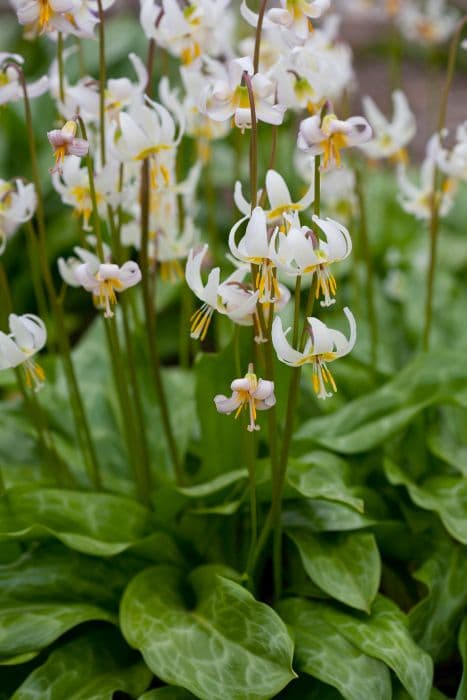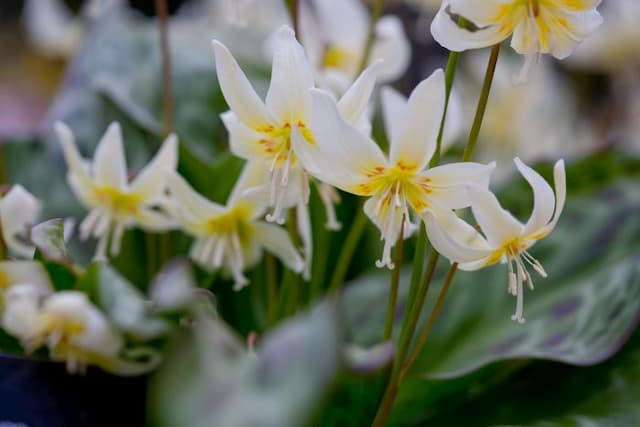Albert Tulip Tulipa albertii (15)

ABOUT
Tulipa albertii, commonly referred to as Albert's tulip, is a plant with a distinguished appearance characterized by its vibrant and colorful flowers. The plant sprouts from a bulb, which is a storage organ for nutrients that contributes to the plant's seasonal growth cycle. The leaves of Albert's tulip are typically elongated and have a waxy, glossy texture with a deep green color that contrasts beautifully against the colorful blooms. The flowers of Albert's tulip are the most captivating feature. They possess a cup or star-shaped blossoms which often display a rich palette of colors, potentially ranging from yellows to pinks or reds, sometimes with different hues on the petals' interior and exterior. The petals may exhibit a smooth or slightly ruffled edge, and they converge at the base to form the characteristic shape of the tulip. The inside of the petals sometimes reveals a different coloration or pattern, which can include striking markings or a contrasting base color that catches the eye and adds to the overall allure of the flower. In the center of the flower, reproductive structures such as stamens and pistils are visible, often with a color that complements the petals. These structures are essential for the pollination process and subsequent seed formation. The plant's blooms are perched atop slim, yet sturdy stalks which rise above the foliage, making the flowers a focal point for anyone admiring them. Albert's tulip, with its captivating beauty, is a herald of spring in gardens and natural settings where it is cultivated or grows wild.
About this plant
 Names
NamesFamily
Liliaceae
Synonyms
Albert's Tulip, Albert Tulip
Common names
Tulipa albertii
 Toxicity
ToxicityTo humans
The plant commonly known as Tulip (Tulipa albertii) is considered to have a low level of toxicity to humans. However, all parts of the tulip contain allergenic lactones or similar alkaloid substances which can be irritating to the skin and mucous membranes. Upon ingestion, these compounds may cause symptoms such as nausea, vomiting, diarrhea, and abdominal pain. In severe cases, ingestion can lead to dizziness, difficulty breathing, and an irregular heartbeat. Although serious cases are rare, it is advisable to seek medical attention if significant quantities are ingested, especially by children, or if allergic reactions are observed.
To pets
In pets, the Tulip (Tulipa albertii) is known to be toxic, particularly the bulb, which contains compounds that can cause gastrointestinal irritation. If a pet ingests parts of a tulip, especially the bulb, they may exhibit symptoms such as vomiting, diarrhea, drooling, and depression. More severe reactions can include changes in heart rate and respiration, which can be potentially life-threatening. If you suspect your pet has ingested tulip plant material, it is important to consult a veterinarian immediately.
 Characteristics
CharacteristicsLife cycle
Perennials
Foliage type
Deciduous
Color of leaves
Green
Flower color
Red
Height
1 foot (30 cm)
Spread
1 foot (30 cm)
Plant type
Bulb
Hardiness zones
7
Native area
Central Asia
Benefits
 General Benefits
General Benefits- Ornamental Value: Tulipa albertii, commonly known as Albert tulip, is prized for its attractive, cup-shaped flowers, adding aesthetic appeal to gardens and landscapes.
- Pollinator Attraction: The bright and showy flowers of the Albert tulip are known to attract pollinators such as bees, which are essential for the pollination of many plants.
- Seasonal Interest: Albert tulips typically bloom in spring, providing a seasonal interest with their vibrant colors after a long winter.
- Ease of Care: Tulips are generally low-maintenance plants, and Tulipa albertii is no different, making it a suitable choice for gardeners at all skill levels.
- Versatility in Landscaping: These tulips can be used in various landscaping designs, including beds, borders, and as cut flowers for indoor decoration.
- Cultural Significance: Tulips, including the Albert tulip, have a rich history and cultural significance in many societies, often symbolizing love and the arrival of spring.
 Medical Properties
Medical PropertiesThis plant is not used for medical purposes.
 Air-purifying Qualities
Air-purifying QualitiesThis plant is not specifically known for air purifying qualities.
 Other Uses
Other Uses- Tulip petals are occasionally used as a natural dye for fabrics and textiles, providing a soft color palette.
- The bulbs of the Tulip can be crushed to create a glue-like substance used in traditional crafts or bookbinding.
- Some cultures use dried Tulip petals as confetti in festive celebrations or ceremonies due to their biodegradability.
- Tulip flowers can be a source of inspiration for artists and have often appeared in still-life paintings and floral designs.
- The sturdy stems of Tulips may be incorporated into small-scale construction of decorative items such as wreaths or centerpieces.
- In culinary practices, some high-end restaurants use Tulip petals as edible decorations to add elegance to their dishes.
- Tulip petals have been used in perfumery, with their essence contributing to particular floral scents.
- Due to their unique shape, the hollowed bulbs of Tulips can be used as molds for chocolates or confectioneries.
- Tulip flowers may serve as a natural indicator of soil health, with changes in bloom or color signaling the need for soil amendments.
- The vibrant colors of Tulips make them useful in color therapy practices, where they are thought to have mood-enhancing effects.
Interesting Facts
 Feng Shui
Feng ShuiThe Tulip is not used in Feng Shui practice.
 Zodiac Sign Compitability
Zodiac Sign CompitabilityThe Tulip is not used in astrology practice.
 Plant Symbolism
Plant Symbolism- Perfect Love - The tulip, in general, symbolizes perfect love, representing a lover's heart with its black center that's said to be ablaze with passion.
- Declaration of Love - Giving a tulip is a means of declaring one's love. The bold shape and colors of the Tulipa albertii echo the directness of this message.
- Renewal - As tulips are among the first flowers to bloom in spring, they symbolize new beginnings and renewal.
- Fame & Fortune - In the 17th century, tulips were highly valued and can represent one's desire or experience of prosperity and fame.
- Charity - In the Victorian language of flowers, tulips also signify charity and support for the less fortunate.
- Forgiveness - Offering a tulip can be a way of asking for forgiveness, given their association with grace and elegance.
 Water
WaterWater Red Tulips (Tulipa albertii) sparingly since they are drought-tolerant plants and overwatering can lead to bulb rot. During the active growth period in spring, water them once a week with about half a gallon per square yard if there hasn't been significant rainfall. After blooming, as the leaves yellow, gradually reduce watering to allow the bulbs to enter dormancy. In the fall, before the ground freezes, give them one last deep watering of a gallon per square yard to help them establish roots for the next season.
 Light
LightRed Tulips thrive in full sunlight, so plant them in a spot where they receive at least six hours of direct sunlight daily. They can tolerate partial shade, especially in hot climates, but too much shade can result in weak stems and fewer blooms.
 Temperature
TemperatureRed Tulips prefer cooler temperatures and require a period of cold dormancy. They can survive winter temperatures well below 32°F, but they should be planted in an area where the soil doesn't warm up too much, ideally between 35°F and 55°F. The bulbs should not be exposed to temperatures above 70°F once they have started to sprout.
 Pruning
PruningPruning is not generally needed for Red Tulips unless you are removing spent flower heads to prevent seed production. Deadheading after blooms fade can conserve plant energy, but leave the foliage until it turns yellow and dies back naturally to allow photosynthesis which replenishes the bulb.
 Cleaning
CleaningAs needed
 Soil
SoilFor the Wild Tulip, prepare a well-draining soil mix with ample organic matter. Aim for a slightly acidic to neutral pH between 6.0 and 7.0. A blend of loam, sand, and compost works well to mimic their natural habitat and ensures proper drainage and nutrient availability.
 Repotting
RepottingWild Tulips typically do not require frequent repotting. They can be repotted every 3 to 5 years, or once the bulbs multiply and the container becomes crowded, to ensure adequate space for growth and to refresh the soil.
 Humidity & Misting
Humidity & MistingWild Tulips prefer moderate humidity levels. While they can tolerate a range of humidity conditions, maintaining a level between 40-70% is conducive to their health, particularly during their active growing season.
 Suitable locations
Suitable locationsIndoor
Place Wild Tulip in bright indirect light and cool temperatures.
Outdoor
Plant Wild Tulip bulbs in fall, full sun, well-drained soil.
Hardiness zone
3-8 USDA
 Life cycle
Life cycleTulipa albertii, commonly known as Albert's Tulip, begins its life cycle as a bulb, which remains dormant underground during the hot summer months. Upon the arrival of cooler temperatures and adequate moisture in autumn, the bulb sprouts roots and a shoot that emerges from the soil as temperatures further drop. In spring, the shoot matures into a stem bearing lance-shaped leaves and a single cup-shaped flower, usually red with a yellow base, which is pollinated by insects. After pollination, the flower develops into a capsule fruit containing seeds. Once the seeds are dispersed, they may germinate and grow into new bulbs if the conditions are right. However, more commonly, the existing bulb will enter a period of dormancy again after the above-ground plant parts have withered, completing its annual life cycle.
 Propogation
PropogationPropogation time
Spring
Tulipa albertii, commonly known as Albert's tulip, is generally propagated through its bulbs. The best time for propagation by bulbs is during the dormant period after the foliage has died back, typically in late summer to autumn. To propagate Albert's tulip, carefully dig up the mature bulbs after the leaves have yellowed and dried, which indicates that they have completed their growth cycle for the year. Gently separate the offsets, which are smaller bulbs attached to the base of the parent bulb, ensuring that each offset has some of the basal plate for root development. Once separated, the bulbs can be planted immediately or stored in a cool, dry place for later planting. Offsets should be planted about 6 to 8 inches (15 to 20 cm) deep and spaced approximately 4 to 6 inches (10 to 15 cm) apart in well-drained soil with good exposure to sunlight. This method is popular due to its simplicity and effectiveness in producing blooms identical to the parent plant within a few seasons.








